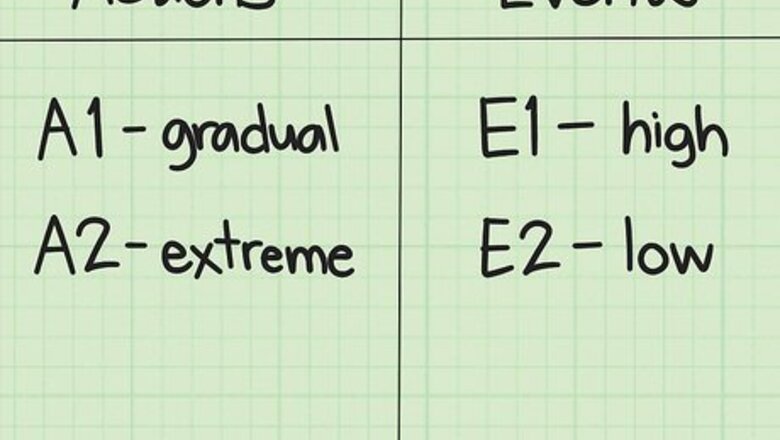
views
X
Expert Source
Madison BoehmBusiness Advisor, Jaxson Maximus
Expert Interview. 24 August 2021.
Doing business is full of decision making. Any decision consists of a choice between two or more events. For each event, there are two or more possible courses of action that you might take. Calculating the EOL is an organized way of using a mathematical model to compare these choices and outcomes, to make the most profitable decision.
Setting up a Payoff Table
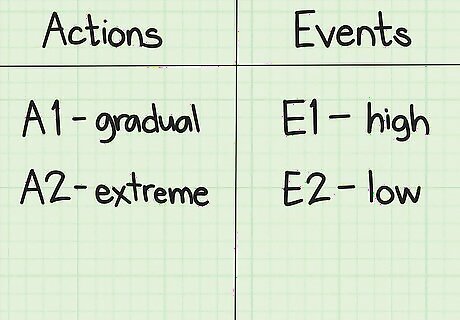
Make a list of possible events and courses of action. Calculating EOL assumes first that there are two or more events that may happen, and, for each event, two or more possible courses of action that you could take. You need to begin by listing each event and each course of action that you could choose. For this first step, simply make two columns, headed “Events” and “Actions,” and write your options under each one. For example, suppose you are the head of a marketing department and you must choose between two advertising campaigns for a new product. One is a gradual introduction into the market and the other is a more extreme approach. These are your two “Actions,” which can be designated algebraically as A1 and A2. You do not know whether demand will be high or low. These represent the two “Events,” which can be designated algebraically as E1 and E2.
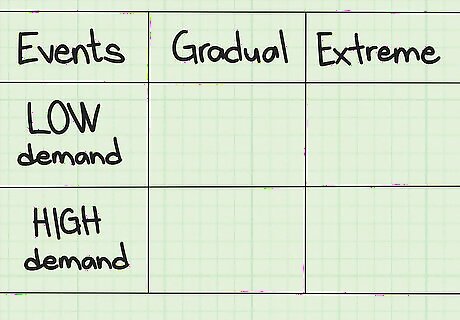
Create a payoff table. A payoff table is a grid that schematically illustrates your events and actions. Across the top row, labeled “Alternative Courses of Action,” write down the names of your two actions. In a column on the right, label it “Events” and list the events that could occur. For the marketing example, your top row will have two columns labeled “Gradual” and “Extreme.” The first column of your payoff table will have the heading “Events.” Under this heading, fill in the labels “High demand” and “Low demand.” Because this particular payoff table had two events and two actions, there should be four blank spaces in the table. You will fill these with data as you proceed.
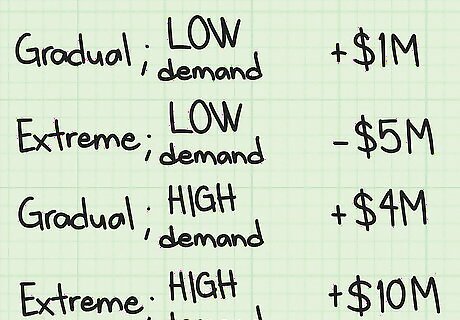
Gather data from research. You will need to make some assumptions or otherwise provide data for the calculations to come. These data will need to come from your knowledge of the field, from marketing research, or any other reliable sources that you use. For the marketing example, assume that research informs you that a gradual marketing campaign in a low demand market will generate a profit of $1 million, while an extreme marketing campaign in a low demand market will create a loss of $5 million. Additionally, you predict that if demand is high, a gradual campaign will create a profit of $4 million, while an extreme campaign in a high demand market will general a profit of $10 million. These assumptions or predictions represent the data that you will use to continue calculating the EOL.
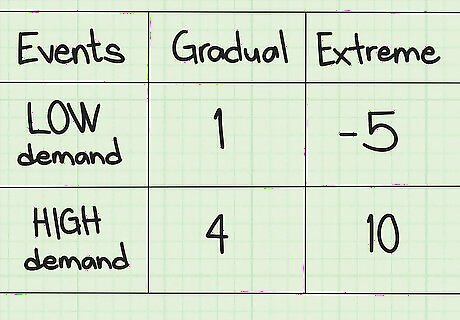
Enter the data into the table. Notice that each of the four blank spaces in the table correspond to some combination of events and actions. Use your predicted or assumed values to complete the blank table. Given the marketing example, the upper left space represents a gradual campaign in a low demand market. Fill in this space with the corresponding value of 1 (you can count in millions for this problem). The second space on the top row represents an extreme campaign in a low demand, with a value of -5. The negative number represents a predicted financial loss. The bottom row should be filled in with 4 and 10, respectively. This completed grid is your payoff table for this problem.
Calculating Opportunity Losses
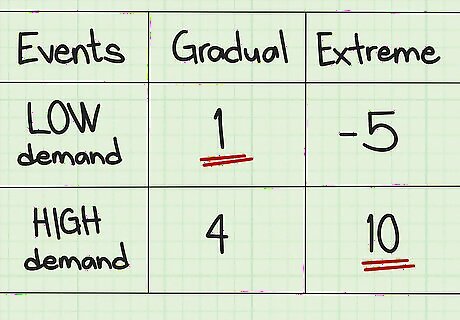
Select the best action for each event. Once the data is complete in your payoff table, it should be easy to spot the most profitable course of action for each possible event. This is just a matter of selecting the highest number in each horizontal row. For example, in a low demand market, your two choices are represented by the values 1 or -5. Because 1 is the greater number, this represents the more valuable choice, which is the gradual marketing campaign. In a high demand market, the extreme marketing campaign shows a higher value of 10, compared to 4 for the gradual campaign.
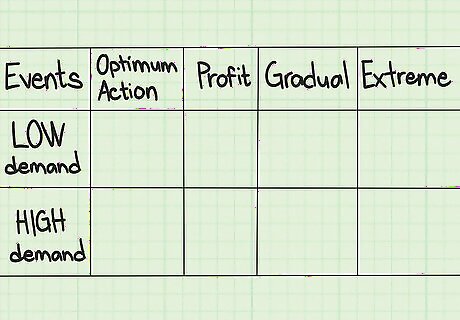
Create a new “Opportunity Loss” Table. This will be a new table that represents the value that you could lose from making any given choice. Set up a table with the same right hand column, representing the possible events. Make additional columns labeled “Optimum Action,” “Profit of Optimum Action,” and then one additional column for each of your alternative courses of action. Working with the marketing example, your headings will be “Optimum Action,” “Profit of Optimum Action,” “Gradual Campaign,” and “Extreme Campaign.” The first column on the right will list the two possible events, Low Demand and High Demand.
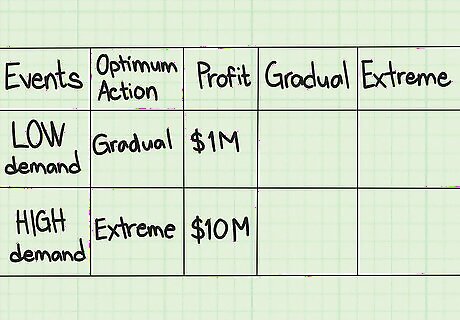
Fill in the data. Using the information from your payoff table, fill in the first few spaces of this opportunity loss table. In the Optimum Action column, the better choice for a low demand market is the Gradual campaign, so write in the word “Gradual.” On the second row, for a high demand market, the better choice is the extreme campaign, so fill in the word “Extreme.” These choices represent incomes of 1 and 10 million dollars, respectively, so enter those numbers in the Profit column.
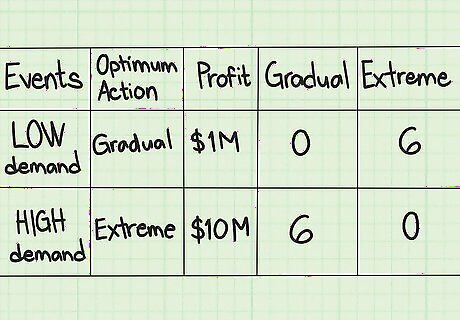
Determine the expected losses for each alternative course of action. In the final columns, you will calculate the amount that you would expect to lose if you had chosen a less optimal course of action. In each space of the table, you will enter the value that corresponds to that action-event combination, subtracted from the optimal event in the previous column. For example, the first space represents the gradual campaign in the low demand market. This has a value of +1. It is also, you should recall, the optimal choice that you selected for this row. Therefore, the “loss” calculation is 1-1, which is 0. This makes sense because it is not really an alternative. It represents the choice that you made. Enter 0 in the first space. The second space represents what you might have lost had you chosen an extreme marketing campaign in a low demand market. Calculate this by subtracting 1-(-5), for a value of +6. Complete the rest of the table in similar fashion. The values in the last two columns should be: 0 6 6 0
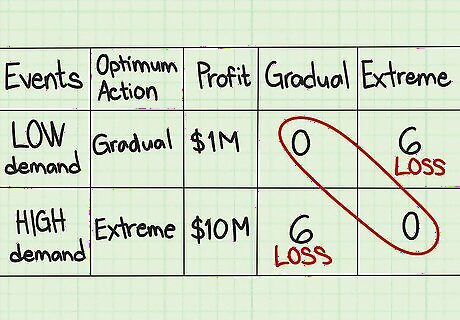
Interpret the completed table. Notice that the values along the main diagonal are all 0. This makes sense because they are comparisons of each choice against itself, so there is no theoretical loss. However, compare the other values and you will see the amount of money that, based on your prediction data, you would lose under each scenario. For example, you made the initial decision that in a low demand market, a gradual campaign would be optimal. Had you chosen the extreme campaign, the table shows that you would expect to lose $6 million. In a high demand market, your optimal choice is the extreme campaign. However, had you chosen the gradual campaign, you would expect to lose $6 million.
Determining the Expected Opportunity Loss
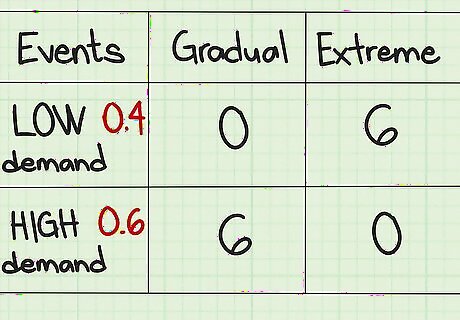
Determine the probabilities of each event. From your company’s research predictions or other source of data, you will need to determine the relative probabilities for each event. For the marketing problem, assume for now that there is 40% chance of a low demand market. Since there are only two event options, this implies, therefore, that there is a 60% chance of a high demand market. You will use the probabilities of 0.4 and 0.6, respectively, in your final calculations.
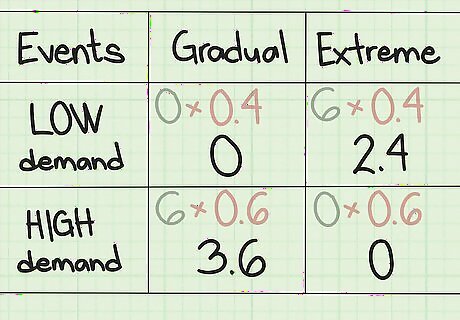
Multiply the probability of each event times the expected losses. Referring to the Opportunity Loss table that you calculated above, multiply each of the predicted losses times the probability of that loss occurring. For example, the top row represents the low demand market, which has a probability of 0.4. Multiply each of the terms in this row by 0.4, to find the expected losses in a low demand market. The second row represents the high demand market, with a probability of 0.6. Multiply each term in this row by 0.6, to calculated these expected losses. The completed table should look like this: (0)(.4)=0 (6)(.4)=2.4 (6)(.6)=3.6 (0)(.6)=0
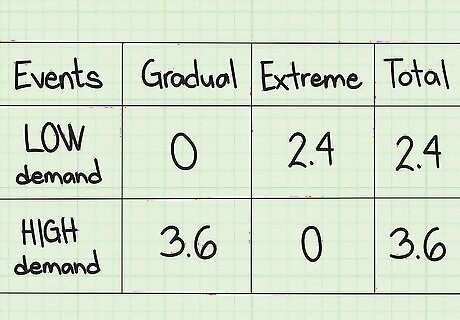
Find the sum of each column. Each column represents the expected losses for each course of action you might choose, taking into account the probability of each event’s occurrence. When you add them together, you get the weighted total for each course of action. In this example, the first column is the gradual marketing campaign. Add the values 0+3.6 to get an expected loss of $3.6 million if you choose that marketing campaign. The second column represents the extreme marketing campaign. Total those figures to get 2.4+0=2.4. This suggests an expected loss of $2.4 million from electing that advertising campaign. Notice that these calculations are very simplistic, because this is a simple 2x2 model. In a real situation, you would have more options and more probabilities to consider. The sum total of the probabilities would be more meaningful.
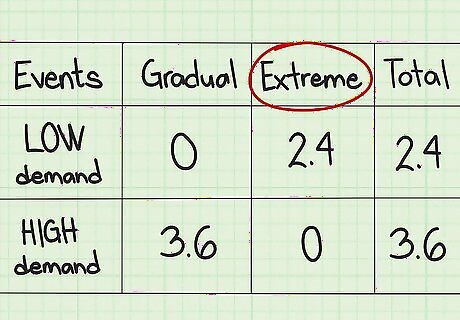
Interpret your results. These results show the expected opportunity loss of choosing the “wrong” course of action under given circumstances. To optimize your profit, you would select the course of action that corresponds to the lowest EOL. In this marketing example, the better choice would be to go with the extreme marketing campaign, as the chance of a higher payoff is higher, and the lost opportunities from the gradual campaign alternative are reduced.




















Comments
0 comment